Nieuwbouw Bibliotheek Universiteit van Amsterdam (UvA)
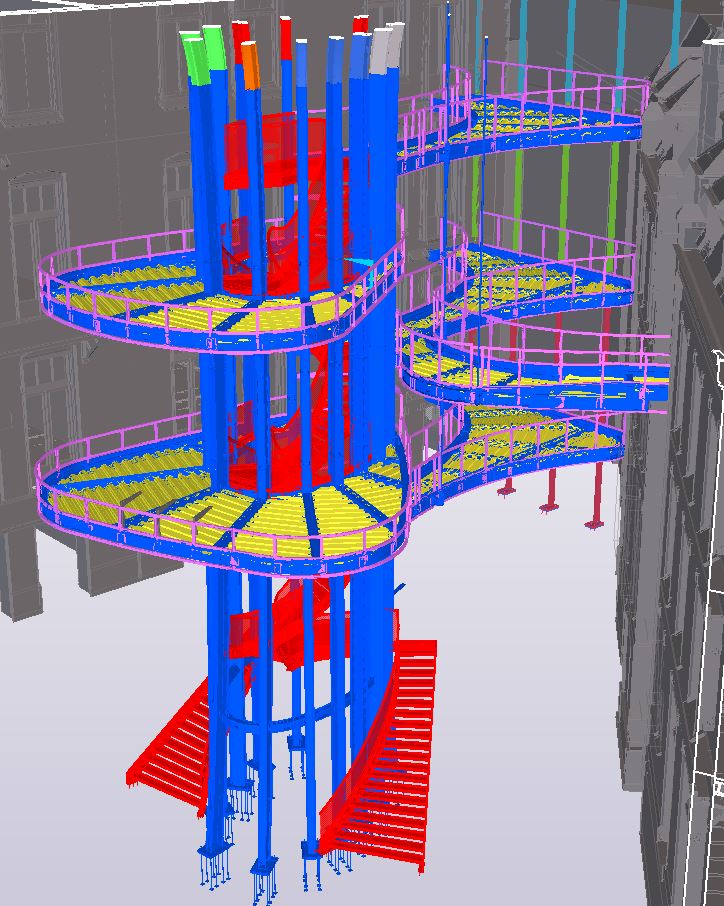
| Categoria | Proiecte comerciale |
|---|---|
| Anul | 2022 |
| Țara | Benelux |
| Organizația | Buiting Staalbouw B.V. |
| Autor | Arthur Heesen |
| Coautori | Jelmer van Riel |
| Client | BINX Smartility te Groenlo |
| Locația construcției | Amsterdam |
| Tags |
In de historische binnenstad van Amsterdam worden de monumentale panden van het voormalige Binnengasthuisziekenhuis gerenoveerd, in combinatie met een deel nieuwbouw en een spectaculair “glazen” atrium dak, tot een state of the art bibliotheek voor de Universiteit van Amsterdam. Met een totale oppervlakte van 12.500 m2 biedt de nieuwe bibliotheek ruimte voor o.a. 1.000 studieplekken, 4 werkgroepzalen en 1 collegezaal. Een buitengewoon indrukwekkend ontwerp met respect voor monumentale waarde ontwikkeld door een samenwerkingsverband tussen MVSA Architects / Archtectenbureau J. van Stigt. Het resultaat mag er zijn, namelijk een architectonisch bijzonder en modern academisch gebouw: een bibliotheek en ontmoetingscentrum met internationale allure!
Kenmerkend is o.a. de “glazen” overkapping die zich vanuit een 20 meter hoge stalen “boom” constructie ontpopt als een enorm uitgestrekt blad over de vide naar de bestaande gebouwen. Hierdoor ontstaat eenheid tussen de bestaande gebouwen en daarmee een centraal atrium, waarin voor het onderwijs en onderzoek ontmoeten en interactie centraal komen te staan. Buiting Staalbouw is bijzonder trots dat er een beroep wordt gedaan op onze kennis, kunde en ervaring om de staalconstructie voor dit prachtige binnenstedelijke project te mogen realiseren in samenwerking met de “Binxmakers”.
De staalconstructie is er één van de buitencategorie, waarbij de grenzen van meerdere staalbouwkundige disciplines worden genaderd. Gelijk aan het ontwerp een indrukwekkende staalconstructie vol uitdagingen, maar bovenal uniek. Uniek omdat in de staalconstructie van het atrium dak geen onderdeel twee keer voorkomt. Uitdaging vinden we in de uit plaat samengestelde constructieve 3D-knooppunten en de stalen “ellips” ringen uit kokerprofielen die in werkelijkheid geen ellips zijn. Verder vinden we uitdagingen in de fors uitkragende bordessen als onderdeel van de stalen “boom” constructie, de in de boom geïntegreerde stalen wokkeltrap en een 3D rvs liaanconstructie voor de hemelwaterafvoer. Kortom deze staalconstructie biedt heel veel complexe uitdagingen op niet alleen onderdeelniveau, maar ook zeker op het beheersen van de maatvoering aangezien de constructie in prefab delen wordt aangevoerd, gemonteerd en vervolgens volledig in het werk wordt afgelast. Om er zeker van te zijn van dat de onderdelen op de bouwplaats nauwkeurig op elkaar aansluiten, wordt de gehele staalconstructie van de kap vooraf in de werkplaats met total station uitgezet en opgebouwd.
Om deze uitermate complexe staalconstructie met succes door het uitvoeringsproces te leiden, is de 3D-modeleersoftware Tekla Structures in combinatie met BIM onmisbaar. Ondanks de ingewikkelde unieke vorm van elke afzonderlijke 3D-knoop, hebben we deze met Tekla Structures praktisch en overzichtelijk vorm weten te geven voor een eerste proefversie / mockup. Voorts heeft deze aanpak geleid tot een bruikbaar 3D-model.
BIM biedt de ongekende mogelijkheden om disciplines bij elkaar te brengen als bijvoorbeeld essentieel in dit project de integratie van inmetingen / 3D-scans van de bestaande gebouwen in relatie tot de staalconstructie van de atriumkap. Maar ook de integratie van het ondersteunende steiger heeft geleid tot perfect positioneren van de benodigde steunpunten.
In the historic city center of Amsterdam, the monumental buildings of the former Binnengasthuis hospital are being renovated, in combination with a new construction part and a spectacular „glass” atrium roof, into a state-of-the-art library for the University of Amsterdam. With a total surface of 12,500 m2, the new library offers space for 1000 study places, 4 workgroup rooms and 1 lecture hall. An extraordinary impressive design with respect for monumental value, developed by a partnership between MVSA Architects / Architectenbureau J. van Stigt. The result is impressive, namely an architecturally special and modern academic building: a library and meeting center with international allure!
Characteristic is, among other things, the „glass” roof that emerges from a 20-meter high steel „tree” construction as an enormously expansive leaf over the void to the existing buildings. This creates unity between the existing buildings and thus a central atrium in which meeting and interaction are central for education and research. We, Buiting Staalbouw, are very proud that our knowledge, skills and experience are being appealed to, to be able to realize the steel construction for this beautiful inner-city project in collaboration with the „Binxmakers”.
The steel construction is an exceptional one, where the boundaries of several steel engineering disciplines are being approached. Similar to the design, the steel construction is impressive, full of challenges, but above all unique. Unique because no part occurs twice in the steel construction of the atrium roof. We find challenge in the plate-composed constructive 3D node points and the steel “ellipse” rings made of box profiles, which in reality are not an ellipse. Moreover, we also find challenges in the strongly cantilevered platforms as part of the steel “tree” construction, the steel wok staircase integrated into the tree and a 3D stainless steel vine construction for rainwater drainage. In short, this steel construction offers many complex challenges. Not only at the component level, but also certainly with regard to controlling the dimensions, since the construction is supplied in prefab parts, assembled and then completely welded on site. To ensure that the parts on the construction site fit together accurately, the entire steel structure of the hood is set out in advance in the workshop with a total station.
To successfully guide this extremely complex steel construction through the implementation process, the 3D modelling software Tekla Structures, in combination with BIM is indispensable. Despite the complicated unique shape of each individual 3D node, we managed to give it a practical and clear shape with Tekla Structures for a first trial version / mock-up. Furthermore, this approach has led to a useful 3D model.
BIM offers unprecedented possibilities to bring disciplines together, such as the integration of measurements / 3D scans of the existing buildings in relation to the steel construction of the atrium roof, which is essential in this project. But also the integration of the supporting scaffolding has resulted in perfect positioning of the required support points.

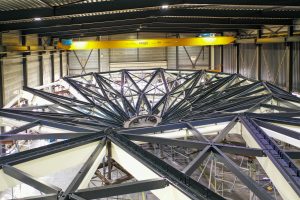

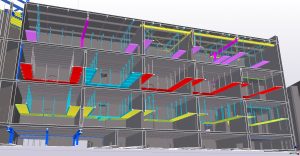




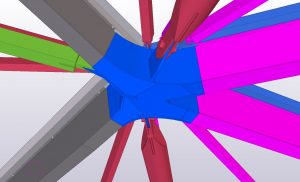
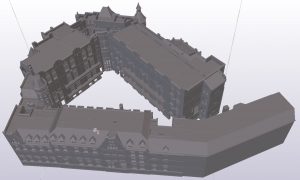

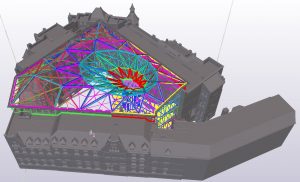

Go Jelmer!